Mountain clematis: characteristics, planting, care
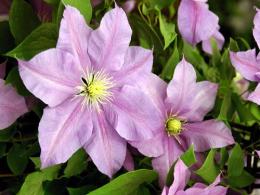
Mountain clematis is a plant from the Ranunculaceae family. This beautiful woody vine is currently one of the most sought after for decoration. garden plots. This is primarily due to the fact that many mountain clematis reach a height of up to 8 meters, which makes them indispensable for vertical gardening.
But the most remarkable thing is the clematis - clematis - for its flowers. Looking at them, a logical question arises: how difficult is it to grow mountain clematis on your own, how to care for it in order to get a flowering vine in the garden.
Content:
- Clematis or mountain clematis, plant characteristics
- Where and how to plant montana clematis in the garden
- Planting mountain clematis seedlings, care
Clematis or mountain clematis, plant characteristics
At the beginning of the 19th century, European botanists discovered a deciduous vine with snow-white flowers in the Himalayas and in a number of provinces of China. The plant is called clematis montana. In Russia clematis called clematis, in Belarus - warthog, in England - witch's rope or old man's beard.
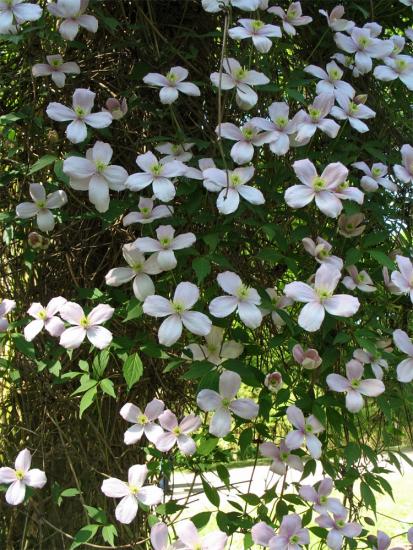
First of all, numerous names are associated with their appearance, since its fruits - multi-nuts - have spout-like outgrowths covered with white fluffy hairs, and the shoots - vines - bend bizarrely and resemble numerous tangled ropes.
Clematis climbs along vertical supports using long leaf petioles. The leaves are most often trifoliate, pointed upward with a serrated edge.In summer they are dark green, but by autumn they can change color to yellow-orange.
Quite large flowers are formed on the shoots of the previous year. There are species with both single flowers and those collected in inflorescences - corymbs or panicles. In the wild, the flowers of mountain clematis are usually white or light pink in color; in cultivated gardening there are varieties with flowers:
- dark pink
- creamy
- lilac
- white
- bright pink
Since this is deciduous liana found in natural conditions even at an altitude of up to 4 km above sea level, the plant is quite winter-hardy and can withstand frosts down to - 25 degrees without shelter, with shelter up to - 40. Therefore, mountain clematis can be recommended for cultivation not only in the southern regions, but in areas with temperate climate and fairly frosty winters.
Where and how to plant montana clematis in the garden
For mountain clematis, as for any garden plant, the following conditions are vital:
- lighting
- the soil
- watering
- wind protection
Light requirement
When choosing a place for clematis, you should not place it on the north side of the site. The plant is light-loving; if possible, the best direction for its placement is southeast, southwest. It is also possible on the south side, if you follow the watering regime on hot days and mulch the tree trunk circle with peat or sawdust to prevent overheating of the root system. It is important to remember that with a lack of light and strong shading, clematis bloom poorly or do not bloom at all.
Soil and watering
Mountain clematis is a plant that prefers fairly good fertile soil. If the soil in the garden is clayey, then in the place where clematis is planted it is better to replace part of it with looser soil with a high content of fertile soil and a slightly alkaline or neutral reaction.

Clematis love water. In normal summer weather, they need to be watered approximately once every seven days and the amount of water should be at least two buckets. In drought and heat, the frequency of watering is once every three days.
Wind protection
The plant does not tolerate drafts and strong winds. Constant winds have a detrimental effect on shoots, tearing them off natural and artificial supports. The above parameters must be taken into account when landing vines in the area.
Planting mountain clematis seedlings, care
Clematis can grow in one place in the garden for at least 10 years; taking this into account, the planting hole should be 60 cm deep and approximately the same width.
Place a drainage layer of fine gravel at the bottom of the hole. Its height is about 10 cm.
Add to good garden soil per planting hole:
- lime 0.2 kg
- phosphates 0.2 kg
- humus 1 kg
- compost 4-5 kg
- humus 4-5 kg
Mix everything well and fill the pit with this mixture. This must be done in advance, and not on the eve of planting. Lower the seedling into the hole, straighten the roots and cover it with soil along with the root collar up to the first internode. Pour a bucket of water. Spring planting is preferable for regions with cold and temperate climates.
If there is no natural support, install an artificial support next to the mountain clematis. If clematis was planted before winter, then it must be completely covered with soil.
Further care in the first year consists of:
- watering
- loosening
- weed removal
- adding soil
The plant will need feeding from the second year of life.As a rule, during the season they need to be fertilized at least twice a month. If in the second year of life the plant has formed buds and is about to bloom, then it is better to remove them and allow the seedling to grow its root system.
In autumn, the shoots of mountain clematis need to be slightly shortened, and weak, damaged ones, without well-formed buds, should be cut out. The optimal cutting height is 70 cm above a large bud. Some shoots can be shortened to 30 cm above the ground. Mountain clematis propagate not only by cuttings and layering, but also by seeds, which are planted in the spring after stratification for 90 days.
Propagation by cuttings gives good results when treated with growth stimulants. The variety of varieties of mountain clematis allows you to choose a plant in accordance with individual preferences and grow it on your site yourself.
Video on how to make clematis bloom:
Interesting information about the vegetable garden

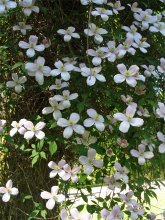
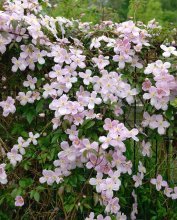

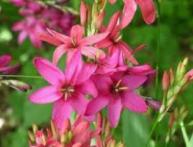
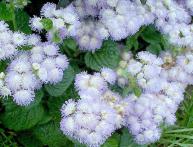

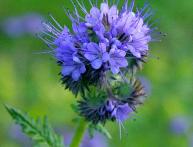

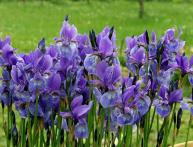
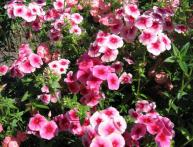
Comments
I have clematis growing. A very beautiful flower, the only drawback is that it is afraid of frost. I have to hide it for the winter. One unfortunately disappeared this winter. That's why he is capricious in his care.
And my mother and I have been trying to grow up for two years now, but he keeps dying, although everything is fine with the neighbors. We cover it, take care of it, but it still doesn’t bloom, it just withers and dries. We have already looked at so many things on the Internet, re-read books - we do everything as told, but there is no result.